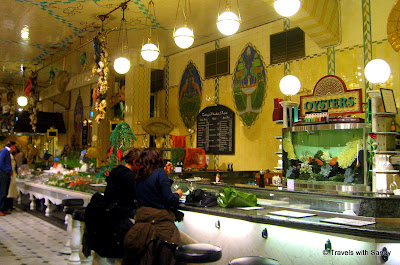We stayed at the Hilton London Tower Bridge for 5 nights on our visit to London in November. This Hilton is located on the South Bank of London and is primarily a business hotel. However, it can be a good alternative for visitors who do not want to pay Central London prices and still stay in a very nice hotel that is close enough.
Despite being across the river from Central London, the Hilton London Tower Bridge proved to be a very convenient location primarily because it is only two short blocks away from the London Bridge tube/railway/bus station. The London Bridge station is only one railway stop away from Charing Cross / Trafalgar Square and one tube stop from Bank Station in the business district (“the city”). In addition, there is a Marks & Spencer mini mart in the same square as the hotel, which is really convenient for breakfast foods, newspapers, snacks, and some groceries. The area felt safe and I was comfortable walking to and from the station by myself.
Check-in was easy and all the staff we interacted with were friendly and helpful.
The actual accomodations were stylish and comfortable. The room was moderately sized by London standards and included all the expected amenities, such as high speed internet (for sale in 24 hour increments) and a flat screen TV.
The bathroom was chic and clean and included both a shower and a tub. After staying at a variety of places overseas, I no longer take this for granted! Shower pressure was excellent.
Overall we had a very nice stay at the Hilton London Tower Bridge and I would recommend it. The hotel does not have much character nor is it particularly London-y but its rates are usually reasonable for this class of accommondation.
I have listed more transportation details below. London has an extremely useful transit website at http://www.tfl.gov.uk/ , which has maps, updates, a trip planner, and other information. I used it frequently and would highly recommend checking it out. The London Bridge station is large and complicated, but basically the tube station is on the 1st floor and the rail station is on the 2nd floor. You can buy tickets from ticket windows or machines and the employees at the station are very helpful. Generally, an Oyster card is worth it but note that it doesn’t cover railway tickets.
To Trafalgar Square:
From London Bridge Railway Station (2nd Floor), take the Southern towards Charing Cross. After crossing the Thames River, alight at Charing Cross, which is at the SW end of Trafalgar Square. Incidentally, Charing Cross station is just one short block from Embankment station, which is on the Circle and District Lines that go around all the sights in Central London.
To Bank/Monument:
From London Bridge Tube Station, take the Northern line North (end of line differs by train, but any one going North will work) for one stop. Disembark at Bank/Monument.































































































































Recent Comments